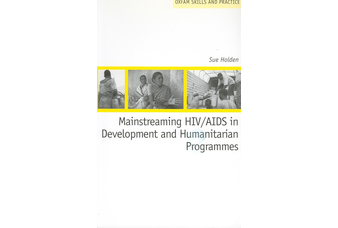Support to Mainstreaming AIDS in Development: UNAIDS Strategy Note and Action Framework
Mainstreaming AIDS is a process that enables development actors to address the causes and effects of AIDS in an effective and sustained manner, both through their usual work and within their workplace.
Although not credited as such, I co-wrote this Strategy Note (minus the Action Framework) with Bob Verbruggen of UNAIDS.
Extract
Twenty years into the pandemic, there is now ample evidence for the complex linkages between AIDS and development: development gaps increase people’s susceptibility to HIV transmission and their vulnerability to the impact of AIDS; inversely, the epidemic itself hampers or even reverses development progress so as to pose a major obstacle to the achievement of the Millennium Development Goals.
The growing understanding of this two-way relationship between AIDS and development has led to the insight that, in addition to developing programmes that specifically address AIDS, there is a need to strengthen the way in which existing development programmes address both the causes and effects of the epidemic in each country-specific setting. The process through which to achieve this is called ‘Mainstreaming AIDS’.
The Rationale for Mainstreaming AIDS in Development
1) Mainstreaming aims at improving development practice so as to enhance its contribution to the response to AIDS:
- By having development actors attend to both the immediate and the underlying determinants of people’s susceptibility to HIV infection:
HIV spreads “along the fault lines of failing development”, such as poverty, gender inequality, poor social services. Mainstreaming enables development actors to strengthen the way in which they help reduce the susceptibility to HIV infection of the people they serve. This implies that they also try to identify and minimize unintended negative effects of their own work, such as increasing gender inequality.
- By having development actors take into account the impact of AIDS and adjust their work accordingly:
AIDS disproportionately hits the most vulnerable groups, and affects the capacity of development actors themselves: it thus deepens existing development problems. Through the process of mainstreaming, development actors analyse and address the impact of AIDS both on their own capacity and on the people they serve, now and in the future.
2) Conversely, mainstreaming is about gradually incorporating national responses into national development processes in order to ultimately equip countries with the capacity to reverse and contain the epidemic. Through the process of mainstreaming, national responses are being institutionalized within national development instruments and processes: this will ensure the sustainability of AIDS programmes and strengthen national coping capacity, thus allowing them to achieve lasting results.
Mainstreaming and the National Response
Considering the above, mainstreaming and national responses are inseparable:
- While all development actors, including international development agencies, need to mainstream AIDS in their work, it is not possible for any of them to respond to the complexity of the causes and effects of AIDS by itself. The intended system-wide impact of mainstreaming can only be achieved if the respective efforts complement and reinforce each other.
- Inversely, for national responses to achieve their ultimate goal of containing the epidemic, they need to address the development-related causes and effects which fuel it through effective mainstreaming processes. Indeed, while HIV prevention work is necessary to inform and motivate people to protect themselves, it cannot overcome deeply-rooted societal causes of susceptibility; similarly, treatment, care and support programmes can reduce the impact of AIDS on affected households, but cannot address the underlying reasons for their vulnerability.
From the above, it is clear that putting in place “specific” AIDS programmes and mainstreaming AIDS in development is not a matter of “either/or”. One of the facets of the exceptionality of AIDS is indeed its character of long-term emergency, which commands a response representing a continuum, from a response attempting immediate relief to a more in-depth developmental response, addressing the societal factors of susceptibility and vulnerability.




